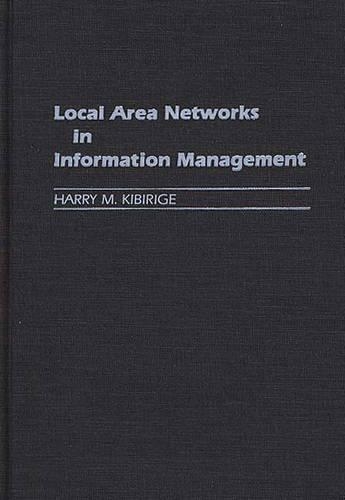
Local Area Networks in Information Management
(Hardback)
Publishing Details
Local Area Networks in Information Management
By (Author) Harry Kibirige
Bloomsbury Publishing PLC
Praeger Publishers Inc
26th April 1989
United States
Classifications
Tertiary Education
Non Fiction
004.68
Physical Properties
Hardback
189
Description
Local Area Networks (LANs) have a high potential for alleviating many of the problems associated with stand-alone microcomputers. Networking microcomputers to share information, software and hardware, as well as facilite electronic mail is not only feasible and desirable, but also logical. Harry Kibirige's issue-oriented study explores microcomputer networking systems with particular emphasis on LANs. Although his analysis emphasizes issues from an information scientist's perspective, readers who want to gain an understanding of LAN technology and its applications should find it useful. Written with a minimum of jargon, the book can be used in academic, corporate, library, federal and state agency, and not-for-profit organizational settings. The author begins with an introduction to the general concepts surrounding LANs. He discusses LANs as structures for processing information and compares and contrasts them with other structures such as time-sharing systems. Also considered are salient factors concerned with LAN design and implementation. In a chapter devoted to choosing an LAN, Kibirige explains in detail the fundamental problems of choice as well as steps which should be taken in making a final selection. Other issues covered are the relationship of LANs to other existing automation programs, significant management issues, currently implemented alternatives to LANS, technology trends which will impact the future of LANs, and social issues concerned with LANs. Finally, Kibirige summarizes the results of the CUNY study of microcomputer networking systems, a report that emphasized information center/libraries.
Reviews
Many recent books have addressed the implementation of local area networks (LANs). Kibirige, as do these other authors, describes the technology behind LANs, such as protocols and standards; however, he adds a unique flavor to his book by discussing the LAN as an information-processing structure--putting more emphasis on the utility of LANs than on the technology. Kibirige argues that the LAN is an information-optimization structure that allows the individual and the organization to get maximum utility from the information services and products available, such as the large external databases, e.g. CompuServe. An interesting chapter, titled The Future of LANs in Information Management, ' discusses the Integrated Services Digital Network (ISDN) in relation to the issue of integrating all forms of communication including voice, video, data, telemetry, and facsimile. Kibirige's background is in library science, and many of the applications he discusses should be of interest to upper-division library science students as well as to computer science students.-Choice
The author succeeds in writing a readable book about LANs. This is important because an understanding of LANs and the other communication technologies discussed here will make the high-tech aspects of the workaday world seem less confusing. The very good introduction defines a LAN as 'a privately owned communication facility that links devices in a small area.'-Insights
"The author succeeds in writing a readable book about LANs. This is important because an understanding of LANs and the other communication technologies discussed here will make the high-tech aspects of the workaday world seem less confusing. The very good introduction defines a LAN as 'a privately owned communication facility that links devices in a small area.'"-Insights
"Many recent books have addressed the implementation of local area networks (LANs). Kibirige, as do these other authors, describes the technology behind LANs, such as protocols and standards; however, he adds a unique flavor to his book by discussing the LAN as an information-processing structure--putting more emphasis on the utility of LANs than on the technology. Kibirige argues that the LAN is an information-optimization structure that allows the individual and the organization to get maximum utility from the information services and products available, such as the large external databases, e.g. CompuServe. An interesting chapter, titled The Future of LANs in Information Management, ' discusses the Integrated Services Digital Network (ISDN) in relation to the issue of integrating all forms of communication including voice, video, data, telemetry, and facsimile. Kibirige's background is in library science, and many of the applications he discusses should be of interest to upper-division library science students as well as to computer science students."-Choice
Author Bio
HARRY M. KIBIRIGE is Assistant Professor of Information Science at the Graduate School of Library and Information Studies, Queens College of the City University of New York. He is the author of The Information Dilemma: A Critical Analysis of Information Pricing and the Fees Controversy (Greenwood Press, 1983). In addition, he has published several articles and conference papers on information systems analysis, design and management.
